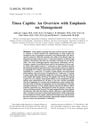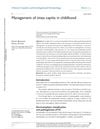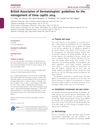TLDR Itraconazole effectively treats scalp fungus, with continuous use more effective than pulse therapy.
In a clinical trial conducted 18 years ago, 81 patients (49 boys and 32 girls) suffering from tinea capitis caused by Microsporum ferrugineum were treated with itraconazole. The patients were divided into two groups: one received continuous itraconazole treatment and the other received pulse therapy (one week on, three weeks off). Both groups also used 2% ketoconazole shampoo daily. The study found that the overall clinical severity score decreased with each visit (p < 0.001), with no significant difference between the two groups. However, the cumulative cure rate at week 16 was higher in the continuous treatment group (54.3% or 19 out of 35 patients) compared to the pulse therapy group (37.0% or 17 out of 46 patients). The study concluded that continuous itraconazole treatment was more effective, especially after week 8, and suggested that a higher dosage or longer treatment duration may be required to increase the cure rate. No significant adverse effects were reported.
46 citations
,
January 2002 in “Paediatric drugs” Tinea capitis, a scalp fungal infection in children, is best treated with newer antifungal agents for shorter periods.
 89 citations
,
May 1999 in “Pediatric Dermatology”
89 citations
,
May 1999 in “Pediatric Dermatology” New antifungal treatments for a children's scalp infection are effective and safe, but it's not decided if they will become the preferred option over the old treatment.
 33 citations
,
February 1996 in “Journal of The American Academy of Dermatology”
33 citations
,
February 1996 in “Journal of The American Academy of Dermatology” Treat scalp and beard fungal infections early with oral antifungal medication and sometimes topical therapy, avoiding unnecessary allergy tests and surgery.
 August 2025 in “Bioscientia Medicina Journal of Biomedicine and Translational Research”
August 2025 in “Bioscientia Medicina Journal of Biomedicine and Translational Research” Environmental factors like shared combs can spread tinea capitis, and trichoscopy helps diagnose it.
 89 citations
,
May 1999 in “Pediatric Dermatology”
89 citations
,
May 1999 in “Pediatric Dermatology” New antifungal treatments for a children's scalp infection are effective and safe, but it's not decided if they will become the preferred option over the old treatment.
 38 citations
,
July 2010 in “Clinical, cosmetic and investigational dermatology”
38 citations
,
July 2010 in “Clinical, cosmetic and investigational dermatology” To treat tinea capitis in children, oral antifungal medication is necessary, with newer drugs offering shorter treatment times than the traditional griseofulvin.
 156 citations
,
September 2014 in “British journal of dermatology/British journal of dermatology, Supplement”
156 citations
,
September 2014 in “British journal of dermatology/British journal of dermatology, Supplement” Accurate diagnosis and effective oral treatment are key to managing tinea capitis and preventing its spread.
 65 citations
,
January 2005 in “American journal of clinical dermatology”
65 citations
,
January 2005 in “American journal of clinical dermatology” Children with scalp fungal infections need proper diagnosis and treatment, usually with antifungal medications, and newer drugs may offer quicker recovery.





